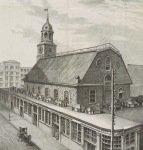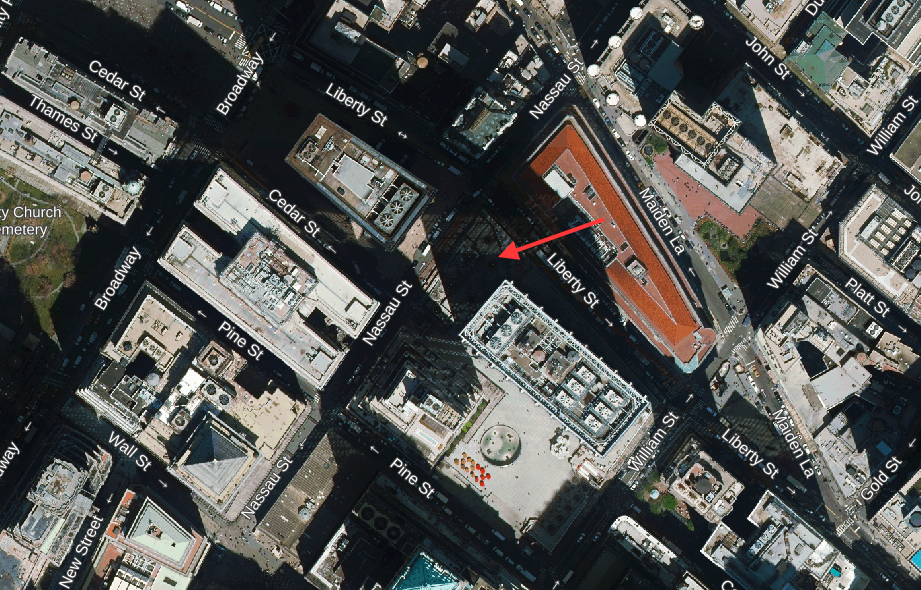
In the early 18th century the Reformed Dutch Church at Exchange Place in Lower Manhattan found it necessary to build a second church to accommodate their growing congregation. The New Dutch Church opened in 1729 on the east side of Nassau Street, between Cedar and Liberty Streets. It was a substantial stone building, 100 feet long and 70 feet wide, with a tall steeple and bell. In the winter of 1732-33, an administrative committee established rules and regulations for burials in the churchyard of the New Church. Plots for vaults or graves “shall be at least six feet long and nine broad,” the rules read, and “at least six feet from the Church wall.” Vaults were to be built of stone or brick at the plot owner’s expense, and the owner was responsible for keeping it in repair. For the sum of £15 “in New York currency,” the owner acquired the right of burial in the plot “for himself and his heirs forever.”

Obituaries for those interred in the churchyard of the New Dutch Church appear with great frequency in early New York newspapers. Among them are death notices for John Van Der Speigel, “a Gentleman of unblemished Character” interred in the family vault in the New Dutch Churchyard in 1770; Ann Low, “an affectionate Wife and indulgent Mother” laid to rest here in 1772; Nicholas Gouverneur, “an ancient and respectable inhabitant of this city” transported to the family vault after he died at his country seat near Newark in 1786; and Martha Washington Clinton, the 13-year-old daughter of then-governor (and later United States vice-president) George Clinton, whose remains were “conveyed from the Government House and deposited in a vault in the New Dutch Church Yard” in 1795.

Around the turn of the 19th century, the New Dutch Church on Nassau street became known as the Middle Dutch Church because it was situated between the old Dutch Church (or South Dutch Church) on Exchange Place and the North Dutch Church built in the late 1700s at William and Fulton streets. As Lower Manhattan became increasingly devoted to business activity in the 1800s, families moved northward and all three of the Reformed Dutch Church congregations eventually relocated uptown. In 1839, the Middle Dutch Church moved to a new building at Lafayette Place and Fourth Street; the congregation continues today as the Middle Collegiate Church at Second Avenue in the East Village.

In 1844 the Middle Dutch Church building at Nassau Street was leased to the United States government and converted into a post office. The following year, the church obtained permission from the city’s Board of Aldermen to remove remains from the churchyard to their new property at Lafayette Street, but it is unclear if removals were actually made at this time. When the U.S. government sought to purchase the Nassau Street property in 1860, the title was disputed because many of the vaults surrounding the building were still tenanted and owners were actively using them for interment of family members. Some families were surprised to find that their vaults had been emptied without their permission and accused church trustees of boxing up and removing remains “stealthily and at night to a distant part of the city.”
Coffins and human remains were found in several of the old burial vaults in 1877 when the post office (the former Middle Dutch church building) was converted into shops. Workers removed 49 boxes of human remains from the site between November 1882 and January 1883 when the building and vaults were demolished to make way for the Mutual Insurance Company building; these remains were transferred to a plot at Greenwood Cemetery. Most of these burials could not be identified, but coffin plates recovered from one vault in November 1882 named three of those interred there. One plate read “Gerrard Steddiford, died 3d April 1820, aged 67 years, 7 months, and 7 days;” another was inscribed “Louisa Matilda Von Antwerp, died 1st March 1822, aged 3 years 11 months;” and the third was marked “Peter Kemble, Jr. died 19th November, 1813, aged 26 years.” Today One Chase Manhattan Plaza stands atop their former burial ground.

Sources: Taylor-Roberts 1797 New and Accurate Plan of the City of New York; A History of the Churches of All Denominations in the City of New York from the First Settlement to the Year 1846 (Greenleaf 1846); Ecclesiastical Records, State of New York, Vol 4; The Iconography of Manhattan Island: 1498-1909 (Stokes 1915-1928), Vol 1; Bodies in Transit Register X:1881-1894, Municipal Archives, City of New York; “John Van Der Spiegel,” New-York Journal, Aug 30, 1770; “Ann Low,” New-York Journal, Oct 8, 1772; “Nicholas Gouverneur,” Daily Advertiser, Nov 18, 1786;“Died,” New-York Weekly Chronicle, Feb 26, 1795; “Brigade Orders,” Commercial Advertiser, Mar 26, 1798; “The Middle Dutch Church,” Evening Post, Jan 17, 1845; Journal and Documents of the Board of Assistant Aldermen of the City of New York, Vol XXV Dec 2 1844 to May 12 1845; “Efforts to Establish a Title for the Sale of the Dutch Church,” New York Herald, Aug 8, 1860; “Removal of the Dead,” Brooklyn Daily Eagle, Sep 18, 1860; “The Post Office,” New York Herald, Aug 30, 1875; “Among the Forgotten Dead,” New York Tribune, Jul 6, 1877; “Found at the Old Post Office,” New York Times, Nov 21, 1882; “Five Skeletons Discovered,” New York Times, Nov 24, 1882; “The Old Post Office Building,” New York Times, Nov 26, 1882; “City and Suburban News,” New York Times, Nov 28, 1882; “Demolishing an Old Church,” New York Tribune, Mar 27, 1887
